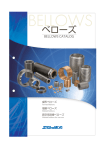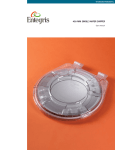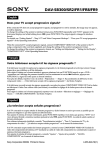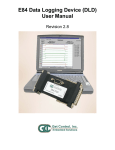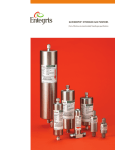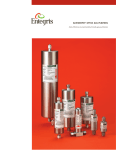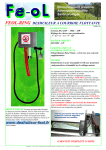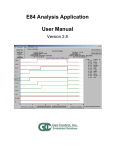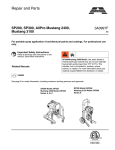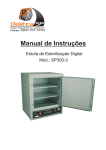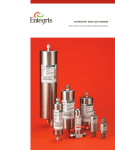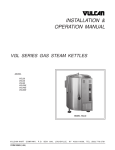Download SB300 FOSB (Front Opening Shipping Box) for 300 mm
Transcript
MICROENVIRONMENTS SB300 FOSB (FRONT OPENING SHIPPING BOX) FOR 300 MM WAFERS User manual SB 300 FOSB for 300 mm wafers Table of Contents Introduction . . ......................................... 2 Specifications . . ....................................... 9 Features . . .............................................. Terminology ............................................. FIMS Compatibility . . .................................. Automated Ergonomic Handling .. ................. Identification ............................................ Cleanability .............................................. Equipment Interface ............................... Load Port Interface. . .................................. Features ................................................. Standard Operation .. ................................. Door Interface Points ................................ Bottom Interface Points .. ........................... 2 2 2 2 2 2 10 10 10 10 11 11 Components and Materials ........................ 3 Door ........................................................ 3 Shell . . ...................................................... 4 General Use Instructions ......................... 13 Manual Assembly. . ..................................... 13 D-ring Handles . . ....................................... 13 Secondary Packaging ............................... 4 Standard Two-pack . . .................................. 4 For More Information ............................. 14 Assembly Instructions .............................. 5 SB300 Options .. ......................................... 5 Product Warranties ................................ 14 Datum Orientation .................................. Horizontal Datum....................................... Facial Datum ............................................ Bilateral Datum ........................................ X, Y and Z Dimensions . . .............................. Structure ................................................. Terms and Conditions .. ............................ 14 6 6 6 6 6 6 SEMI® Standards .. ..................................... 8 Entegris, Inc. 1 SB 300 FOSB for 300 mm wafers Introduction The SB300 is an innovative 300 mm shipper designed to offer the benefits associated with manual and FIMS-compatible automation handling in a FOSB. The dual-functionality of the door allows users to easily move from manual operation to FIMS. Features Terminology Ergonomic Manual Handling • FIMS (Front Opening Interface Mechanical Standard) is the specification characterizing the automated interface between a FOSB and related equipment, as defined by SEMI® E62 • FOSB (Front Opening Shipping Box) is a wafer shipping box with a front-opening interface, as defined by SEMI M31 • Door design allows safe and easy opening and closing in manual mode • Ergonomically designed side handles allow safe carrying of the box FIMS Compatibility • Provides FIMS automation benefits in a FOSB • Reduces labor costs associated with manual door operation • Allows maximum 300 mm loadport interoperability • Ensures accurate equipment interaction Secure Wafer Protection • Automated operation minimizes potential contamination from human interaction • Wafer plane accuracy • Ultrapure, low outgassing materials provide superior protection for wafer shipment • Protects wafers during 1.5 m drop tests • All plastic assembly prevents metallic contamination and corrosion Identification • Innovative insert-molded barcode ensures lifetime identification and traceability • Clear polycarbonate door and shell allow visual observation of wafers • Info pads to detect FOSB differences • Built-in horizontal RFID holder in KC plate • Vertical RFID holder optional • Colored door panels optional Cleanability • Designed for liquid flow-through and drying • Complete door assembly can be cleaned without disassembly 2Entegris, Inc. SB 300 FOSB for 300 mm wafers Components and Materials Door Number Component Material 1 Wafer strip Thermoplastic elastomer (TPE) 1 2 Wafer cushion Polycarbonate (PC) 1 3 Gasket Thermoplastic elastomer (TPE) 1 4 Corner guides Catalogue (POM) 4 5 Door housing Polycarbonate (PC) 1 6 Lift arms PTFE-filled polycarbonate (white) 4 7 Latch arms Acetal (POM) 4 8 Latch cams PTFE-filled polycarbonate (white) 2 9 Latch cover Polycarbonate (PC) 2 1 2 3 4 Quantity 5 Entegris, Inc. 6 7 8 9 3 SB 300 FOSB for 300 mm wafers Shell Number Component Material Quantity 1 Shell housing Polycarbonate (PC) 1 2 Rear retainer Polybutylene terephthalate (PBT) 1 3 KC plate Polycarbonate (PC) 1 4 Filter housing Polycarbonate (PC) 1 5 O-ring Viton® 1 6 Filter media Electrostatic media 1 7 Auto flange (optional) Black polycarbonate (PC) 1 8 Side handles (optional) Black polycarbonate (PC) 2 9 Info pads (optional) Black polycarbonate (PC) 4 1 7 8 6 5 2 9 4 3 Secondary Packaging Standard Two-pack The standard package for SB300 delivery from our factory to the customer with unattached accessories is shown in Figure 1. All parts are single bagged. Outer Box Entegris part # FLA-054-01 Dimensions: 680 mm L × 415 mm W × 365 mm H (26.77" L × 16.34" W × 14.37" H) Corrugated pad Entegris part # FLA-052-03 Dimensions: 393.7 mm L × 337.82 mm (15.5" L × 13.3" W) This package was designed to fit a standard pallet size of 1100 mm × 1100 mm without overhang. Pallet layers contain eight units, maximizing utilization of pallet space. NOTE: This secondary packaging is not designed to ship the SB300s with wafers. 4Entegris, Inc. SB 300 FOSB FOR 300 MM WAFERS Assembly Instructions SB300 Options Auto Flange To install the auto flange: Shell opening 1. Locate tab on auto flange, part number SP300-1003. 2. Insert auto flange on the top of SB300 with tab facing to the SB300 door opening. 3. Pull/push the auto flange until the snap is through the opening on the SB300 shell. Side Handles To install 30-degree handles: 1. Locate the snap detail on the side handle, part number SP300-0900. 2. Place the side handle so both the snap detail and the leading tab of the handle are under the support loops of the shell. 3.WhilesupportingthefrontoftheSB300,pushthe handle further into the support loops on the shell until the snap detail has locked into position. To install 90-degree handles (shown in view to the right): 1. Locate the snap detail on the side handle. 2. Place the side handle against the SB300 so that the snap detail at the base of the handle isunderthelower(KCplateside)supportloop of the SB300. 3. Move the handle downward so that the snap detail at the top of the handle is under the upper support loop. 4. Move the handle upward until the snap detail at both top and bottom of the handle are locked into position. Info Pad To install the info pads: 1. Locate the “flat” side of the info pad, part number 01-031822. 2. Align the flat portion of the info pad with the flat portionontheKCplateinfopadhole. 3. Place the snap features into the desired info pad hole and push the info pad into position until an audible “snap” is heard. The info pad will sit flush withthesurfaceoftheKCplateafterinstallation. ENTEGRIS, INC. 5 SB 300 FOSB for 300 mm wafers Datum Orientation Horizontal Datum The horizontal datum is located near the bottom of the carrier (Figure 1). Frame location for the purpose of automated transfer in and out of the cassette is defined in the Z direction relative to this datum. Left to right Front to back –Y –X +X +Y Bilateral datum Facial datum Up +Z Facial Datum The facial datum is a vertical plane centered on the film frame and oriented left to right. It is used as a reference for front to back Y dimensions. Horizontal datum Figure 1. Datum orientation Bilateral Datum The bilateral datum is a vertical plane centered on the wafers and oriented front to back. It is used as a reference for left to right X dimensions. X, Y and Z Dimensions X dimensions are horizontal left to right. Y dimensions are horizontal front to back. Z dimensions are vertical. Bilateral datum Horizontal datum Structure Datum Orientation Relative to the First Wafer All 300 mm wafers, when fully seated in the shipper, are nominally centered on the vertical line formed by the intersection of the bilateral datum and the facial datum (Figure 2). The bottom of the first wafer, located in the lowest pocket of the FOSB, is located nominally at 44 mm above the horizontal datum. Facial datum 44 mm Figure 2. Datum structure Bilateral datum Facial datum Wafer Spacing Each wafer above the first wafer is located nominally at 10 mm spacing. The tolerance for vertical wafer location is ±0.5 mm for each wafer (Figure 3). The tolerance is non-accumulative. Figure 3. Wafer spacing and tolerance + 0.5 mm - 0.5 mm 6Entegris, Inc. SB 300 FOSB for 300 mm wafers Kinematic Coupling Pins Relative to All Datum 120 mm (4.72”) Facial datum 2 × 80 mm (3.15”) Datum Orientation Relative to an SB300 FOSB The base of the SB300 FOSB is located slightly above the horizontal datum (Figure 5). The bilateral datum and facial datum intersect the FOSB vertically. Bilateral datum The horizontal datum is defined by the kinematic coupling (Figure 4). The machine side of the kinematic coupling consists of three pins of a specified shape in a specified pattern relative to the bilateral datum and facial datum. The kinematic coupling pins protrude through the horizontal datum. A FOSB cannot be effectively opened, closed, loaded or unloaded unless it is properly positioned on a kinematic coupling. Front of Pod 2 × 115 mm (4.53”) Figure 4. Top view of kinematic coupling Bilateral datum Facial datum Horizontal datum Figure 5. Datums and kinematic coupling Entegris, Inc. 7 SB 300 FOSB for 300 mm wafers SEMI Standards SEMI E106 Provided below is a brief description of each applicable SEMI standard and how it applies to the SB300. Please contact your local Entegris representative for information on specific SEMI standard compliance issues. Provisional Overview Guide for Physical Interfaces and Carriers for 300 mm Wafers SEMI E62 Provisional Specification for 300 mm Front Opening Interface Mechanical Standard (FIMS) SEMI E62 describes the features and basic function of the FOSB door opening mechanism. E62 is a very specific standard for the configuration of the equipment, including registration pins, seal zones and latch key shape, position, motion and torque. The 300 mm FOSB must function with these features but the precise mating feature size, position and design are up to the carrier maker. The features of the FOSB that mate with an E62 FOSB door opener are defined by the Entegris design specification. In general, this compatibility involves proper clearance around and location relative to the E62 FOSB door opener features. Since the force required to attach the door to the shell is greater than the door closure force designated by SEMI E62, the SB300 is designated as “FIMS-compatible.” SEMI M31-0999 Provisional Mechanical Specification for Front Opening Shipping Box (FOSB) used to Transport And Ship 300 mm Wafers SEMI M31-0999 is a standard that partially specifies the FOSB used to ship 300 mm wafers from wafer suppliers to their customers (typically IC manufacturers). In this standard only the physical interfaces for the FOSB are specified; no material requirements or micro-contamination limits are given. This standard assumes that the FOSB is used in the last process in wafer manufacturing, in acceptance and inspection, and in transferring the wafers from a FOSB to a FOUP (Front Opening Unified Pod) or open cassette inside an IC manufacturing process. The FOSB is not intended to be used in IC manufacturing processes. SEMI E106 describes the complex interdependencies among SEMI standards for 300 mm physical interfaces and carriers, and explains how standards apply to specific products. SEMI E47.1 Provisional Mechanical Specification for Boxes and Pods used to Transport and Store 300 mm Wafers SEMI E47.1 is a standard that applies to various types of 300 mm pods. The outside shape and overall pod size are limited by this standard. Equipment automation and human interface features are also defined by the standard. SEMI E57 Provisional Mechanical Specification for Kinematic Couplings used to Align and Support 300 mm Wafer Carriers SEMI E57 describes the equipment side of the kinematic coupling that is the universal equipment interface for all types of 300 mm wafer carriers. This standard describes very specifically the shape and position of three pins. The 300 mm carrier must have features, which register with these pins, but the shape of these features is up to the carrier maker to design. The test of a wafer carrier’s compliance to E57 can only be made by placing that carrier on a fixture that is compliant to SEMI E57 and measuring the locations of features relative to the resulting datum structure. 8Entegris, Inc. SB 300 FOSB for 300 mm wafers Specifications • Wafer size: 300 mm (11.81") diameter • Wafer capacity: 25 • Wafer spacing: 10 mm (0.40") • Wafer carrier type: FOSB • Overall dimensions –Height from horizontal datum plane (including auto-top flange): 336.93 mm (13.265") – Width: 385.17 mm (15.164") – Width (with handles): 415.369 mm (16.369") – Depth: 332.77 mm (13.101") 415.8 mm (16.37”) 39.3 mm (1.55”) 385.2 mm (15.16”) 363.7 mm (14.32”) 258.0 mm (10.16”) 25.5 mm (1.00”) 332.8 mm (13.1”) 165.2 mm (6.5”) 330.1 mm (13.0”) Facial 336.8 mm (13.26”) Entegris, Inc. 9 SB 300 FOSB for 300 mm wafers Equipment Interface The SB300 FOSB provides interoperability across a variety of equipment. This section provides an overview of one of the most common interfaces— a load port—and then discusses the door interface features and interfacing recommendations. Door registration pins Load Port Interface Latch keys Primary hold down A load port is a piece of equipment commonly used to provide an interface between a FOSB and a piece of process equipment. Basic load port features are provided below. Features Port door Kinematic coupling pins Most load ports incorporate many of the same basic features. These general features, defined in SEMI standard E15.1, include: • Door registration pins • Kinematic coupling pins • Port door • Latch keys • Primary hold down Standard Operation Basic load port operation is outlined below. Operation of individual load port models will vary. • The FOSB is placed on the load port and located by the kinematic coupling pins • The load port advances the FOSB to the port door, engaging the primary hold down to retain the FOSB on the load port • The door registration pins locate the FOSB door • The latch keys turn 90° to unlatch the FOSB door • The port door and FOSB door are removed, leaving the wafers accessible to the process tool This basic procedure is reversed after the process tool replaces the wafers in the FOSB. 10Entegris, Inc. SB 300 FOSB for 300 mm wafers Door Interface Points Bottom Interface Points Registration Hole and Slot Kinematic Coupling The registration hole and slot are used to properly locate the door. Registration pins on load ports interface with the round registration hole and angled slot to ensure correct door location. The kinematic coupling is used to precisely locate the FOSB on equipment. It incorporates kinematic coupling grooves that accommodate both standard inner and outer kinematic coupling pins. The hole and slot must both be used to properly locate the door. See SEMI E62. Recommendations Automated Key Slots Automated key slots are used for automated actuation of door latches and for retention of the door. The key slots accommodate standard T-type keys. The keys are inserted into the key slot and rotated 90° counterclockwise (as viewed from the FOSB) to unlatch the door. In this position, the keys securely hold the door for removal. When the door is replaced in position, rotating the keys 90° clockwise (as viewed from the FOSB side of the interface) engages the door latches and allows the keys to be removed. The kinematic coupling is the only acceptable interface mechanism for FOSBs and equipment load ports. The primary outer pins offer increased stability and accuracy, and are therefore recommenced for load port interface. The inner pins are less accurate and are recommended for use only in AMHS applications. Related Specifications and Documents • SEMI E57 Hold Down Features The hold down features are used to retain the FOSB in position. Two sets of features are provided. The primary hold down feature, located on the front of the FOSB, is a passive restraint that engages when the FOSB is advanced. The secondary hold down feature is an active restraint, utilizing a keyway slot that accommodates a standard t-shaped key. The key is inserted into the keyway slot and rotated 90° in either direction to hold the FOSB in place. To operate properly, the FOSB must be advanced so it is within 0.5 mm of the load port bulkhead (see SEMI E62). Torque required for key operation is 4.4 Newton meters maximum. Entegris, Inc. 11 SB 300 FOSB for 300 mm wafers Recommendations FEOL and BEOL Pads The primary hold down is for use in applications where the FOSB advances forward to engage the feature. The secondary hold down can be used in load port as well as AMHS applications. Use of the hold down features is recommended to ensure the FOSB cannot be removed from process equipment prior to process cycle completion, and to prevent the FOSB from falling or being knocked off of transport equipment. FEOL (front end of line) and BEOL (back end of line) pads are used to prevent FEOL pods from being processed on BEOL load ports and vice versa, to prevent cross contamination of wafers. Related Specifications and Documents • SEMI E47.1 Sensor Pads Sensor pads are used to verify FOSB presence and proper placement. Recommendations Use of a pin on equipment to provide a physical obstruction in the FEOL or BEOL positions is recommended rather than a presence sensor. Related Specifications and Documents • SEMI E1.9, E47.1, E15.1 Recommendations For accurate operation, use only the recommended sensor pads. Related Specifications and Documents • SEMI E1.9, E47.1 12Entegris, Inc. SB 300 FOSB for 300 mm wafers General Use Instructions Manual Assembly Proper manual assembly of the door to SB300 FOSB is accomplished by aligning the right or left vertical edge of door to the shipper box opening (see Figure 6). Both the bottom Kinematic Coupling surface and back surfaces of the shipper box should be supported when on the angled work surface. Selection of most suitable angle to be used is dependent on the height of the assembly workstation. By using this method of assembly, errors are greatly minimized. However, it is also required that a visual inspection be performed after each assembly to make sure that the wafers are properly engaged with the cushion in the door. This is most easily done when viewing the wafers and cushion through the center of the door. Note: Assembly of the door should never be attempted with the shipper box on its back with the wafers in a completely vertical position as this can result in cross slotting and wafer breakage (see Figure 8). Figure 6. Grip the door and shipper box along the vertical edge (pivot edge) with one hand and rotate the door until the wafer cushion contacts the wafers. Latch the lock on the pivot edge first by rotating the cam counter clockwise 90° using the tabs available, manual latch keys or optional D-rings. Apply inward pressure to the opposite side of the door until it is flush to the shipper box opening and latch closed using the same procedure. It is possible to assemble the SB300 when seated on a horizontal Kinematic Coupling plate, however to aid in assembly, Entegris recommends that the shipper box be placed on an angled surface of 15°–75° degrees as shown in Figure 7. 15°–75° Figure 8. D-ring Handles Manual D-ring handles are used for manually disengaging the door latches and for retention of door. The D-ring handles also incorporate automated key slots for automated operation. The D-rings are simply lifted and then rotated 90° clockwise to unlatch the door. In this position, the D-rings provide a secure handle for removing and replacing the door. When the door is replaced in position, rotating the D-rings keys 90° counterclockwise engages the door latches. Support to prevent tipping Figure 7. Entegris, Inc. 13 Recommendations Make sure the door is properly seated before engaging the latches. Environmental Conditions The SB 300 FOSB is packaged to meet industry accepted cleanroom protocols. This packaging can be used for storage until ready for use. Storage temperature should not exceed 70°C (158°F). Utilize your cleanroom protocol as a guide for removing Entegris packaging material. Product Reuse If the FOSB is properly handled and maintained, it is capable of being reused. In order to maximize the number of reuses, the following guidelines should be followed: • Door and shell should be thoroughly cleaned after each use • The door gasket, wafer cushion and wafer strip should be replaced after each use • Thoroughly inspect the FOSB for damage or excess wear prior to reuse For More Information Please call your Regional Customer Service Center today to learn what Entegris can do for you. Visit www.entegris.com and select the Customer Service link for the center nearest you. Terms and Conditions of Sale All purchases are subject to Entegris’ Terms and Conditions of Sale. To view and print this information, visit www.entegris.com and select the Legal Notices link from the footer. Product Warranties For Product Warranties, visit www.entegris.com and select the Legal Notices link from the footer. Entegris®, the Entegris Rings Design® and Creating a Material AdvantageS M are trademarks of Entegris, Inc. Viton® is a trademark of DuPont Dow Elastomers, L.L.C. SEMI® is a trademark of Semiconductor Equipment and Materials International Corporation ENTEGRIS, INC. Corporate Headquarters | 129 Concord Road | Billerica, MA 01821 USA Customer Service Tel. +1 952 556 4181 | Customer Service Fax +1 952 556 8022 In North America 800 394 4083 | www.entegris.com ©2013 Entegris, Inc. All rights reserved Printed in USA 5550-7429ENT-0713
















